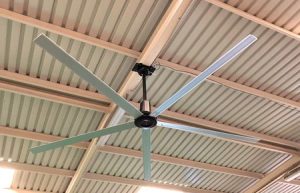Stagnant air and rising energy costs can disrupt the comfort and productivity of your workplace. These problems agitate every occupant dealing with hot spots or poor ventilation. The solution? Discover how an HVLS fan transforms air circulation and ensures a comfortable environment in your commercial or industrial facility.
HVLS fan coverage refers to how much area a high-volume, low speed ceiling fan can effectively ventilate. Typically, the diameter of the fan ranges from 8 feet to 24 feet, creating broad airflow that mitigates stagnant air and promotes optimal performance in large spaces. This coverage area significantly cuts down on energy consumption.

HVLS Fan
A ceiling fan is a mechanical device suspended from the ceiling that circulates air throughout the space. By rotating its ceiling fan blade, it helps redistribute warm or cool air, reducing the reliance on HVAC systems and promoting energy savings in commercial spaces. Whether you install smaller fans or a larger fan, the goal remains the same: boost air movement and maintain a comfortable atmosphere for everyone below.
In commercial and industrial settings, the ceiling fan must be chosen carefully to match the room size. The diameter of the fan determines how effectively air is pushed down to the floor level, ensuring better ventilation and temperature balance. This creates a cooling effect for workers and visitors alike, enhancing comfort and well-being.
An HVLS fan (High-Volume, Low-Speed) is an industrial fans solution designed to deliver massive airflow across expansive areas. These industrial hvls fans typically feature a fan diameter that can range from 8 feet to 24 ft, ensuring the right fan coverage in large buildings such as warehouses, sports arenas, and distribution centers. Thanks to their slow but powerful rotations, these fans offer exceptional destratification, mixing air from the ceiling to the floor and reducing temperature stratification.
By running at low speed, an HVLS fan helps lower energy consumption and maintenance costs, all while moving substantial volumes of air. In many industrial spaces, installing these fans also eliminates stagnant air, promotes both occupant comfort, and maintains overall air quality. As a result, big areas experience consistent airflow coverage, which not only boosts productivity but can also cut energy costs in the long run.
Quick Fact: Studies show that introducing HVLS fans can reduce perceived temperatures by 5°F to 8°F, creating a noticeable cooling effect without significantly altering air conditioning settings.
| Fan Type | Diameter Range | Ideal Coverage | Typical Usage |
|---|---|---|---|
| Small Fan | 4–8 ft (1.2–2.4 m) | Limited area (rooms < 1,000 sq ft) | Offices, small shops |
| Standard HVLS | 8–20 ft (2.4–6.1 m) | Moderate coverage (1,000–10,000 sq ft) | Mid-sized gyms, retail spaces |
| Large HVLS | 20–24 ft (6.1–7.3 m) | Extensive coverage (up to 20,000 sq ft or more) | Warehouses, distribution centers |
Choosing the right size is paramount for effective air circulation and energy efficiency. A smaller fan might not move as much air in a broad space, while an oversized fan may create unwanted turbulence or demand a higher mounting height. Therefore, when you get the right fan for your space, you should measure the square footage of your space, verify the ceiling height, and identify any obstructions that could hinder fan placement.
Additionally, choosing the right size ensures the fan design aligns with your facility’s specific requirements. Remember that different fans serve various coverage needs. A 3-blade model measuring 22 ft in diameter can handle a broader coverage area than smaller fans that only move half as much air. This difference highlights why you must get the right fan to maximize airflow and tap into the best possible energy saving advantages.
Case Study: A manufacturing plant installed HVLS fan units of 20 ft in diameter and experienced a 15% reduction in cooling costs after one summer. By improving air distribution, they lowered indoor temperatures and reduced the burden on their HVAC systems.
In expansive facilities such as gyms, warehouses, and manufacturing plants, the right hvls fan size is crucial. HVLS ceiling fans offer considerable advantages by pushing air throughout the space, lowering perceived temperatures without increasing HVAC load, and improving air quality. The diameter can range from 8 ft to 24 ft, allowing remarkable flexibility and consistent performance in large spaces.
To determine the correct fan for your extensive facility, assess your building’s square footage, ceiling height, and air circulation goals. You should also weigh budgetary constraints, the total required fans are suitable for your environment, and whether you plan to expand in the future. By systematically addressing these considerations, you can foster a comfortable environment and maintain airflow and energy efficiency even in the most complex layouts.
Pro Tip: Always factor in potential growth. If your facility might add new machinery or racks, plan your fan placement so it remains effective after reconfiguration.
HVLS Fan in large spaces
Determining the number of fans required depends on the coverage area, facility layout, and the mounting height of your ceiling. A single HVLS fan often needs at least 1.5 times its diameter in spacing from another fan to prevent overlapping airflow zones. That way, each fan operating at low speed can optimize its cooling effect without infringing on neighboring fans’ coverage.
For instance, if your HVLS units measure 20 ft or 22 ft in diameter, verify that there is adequate space so air can disperse effectively. A higher mounting height can support a broader coverage footprint, though each given space requires unique adjustments. By following these guidelines, you’ll be selecting the right approach to maximize performance, maintain occupant comfort, and ensure consistent air movement.
Stat Alert: Placing fans too close can reduce efficiency by up to 20%, as overlapping air streams cancel each other out or create turbulence rather than a smooth flow.
Selecting the right HVLS ceiling fan size begins with examining the layout of your warehouse or other industrial spaces. The fan blade structure, ceiling height, and fan design all determine how well the air gets distributed from top to bottom. HVLS fans are designed to operate at a gentle pace while still moving a massive volume of air, thus striking a balance between low energy demand and high effectiveness.
When planning your next installation, measure the distance between support columns, shelving racks, and overhead conduits. This assessment will guide you in choosing the diameter of the fan—perhaps 6.7 meters or even 30.5 centimeters more—depending on your specific requirements. Adjusting the diameter for each zone optimizes ventilation, lowers energy consumption, and boosts occupant comfort from top to bottom.
Bonus Insight: Many building managers find that an HVLS setup can lower inside temperature readings by 5°F, which directly translates into employee satisfaction and fewer climate-related disruptions.
HVLS large industrial fan installation in warehouse
HVLS fans also play a key role in reducing energy consumption and raising overall energy efficiency. By moving vast quantities of air at low speed, these fans can significantly lower the burden on your HVAC systems. The cooling effect alone can make occupants feel multiple degrees cooler, delivering a more pleasant environment without forcing your air conditioner to run continuously.
Moreover, an HVLS fan may allow you to raise your thermostat settings by 1.5 or even 2 degrees without increasing occupant discomfort, yielding tangible energy savings. According to numerous case studies, installing HVLS units can cut both heating and cooling expenses, especially in commercial and industrial spaces needing year-round climate control. This synergy of coverage and efficiency provides a strong return on investment for any forward-thinking facility manager.
Data Example: A research survey noted that 68% of facility managers installing HVLS units reported a noticeable drop in monthly power bills—many recouped setup costs in under three years.
One of the greatest benefits of HVLS fan coverage is its ability to deliver air uniformly down to the floor level. This consistent flow helps in improving air conditions for employees, students, or visitors in spaces like sports centers, community halls, and distribution centers. The gentle breeze reduces the risk of overheating, ensuring individuals remain comfortable and alert.
Additionally, a steady stream of air movement at the floor level helps minimize humidity, eliminating hot spots or cold spots. If you have a large open area without partitions, the coverage can spread approximately 1.5 times the fan’s diameter in each direction. Here at our HVLS fans manufacturing facility, we can help you get the right solutions for occupant comfort based on the size and function of your space—whether it’s a gym, warehouse, or manufacturing plant.
Industry Note: Ensuring thorough distribution of air is crucial. A single HVLS fan can keep floor temperatures within 2°F of the ceiling temperature, a major advantage over conventional fans.
In this section, we address frequently asked questions about HVLS fan coverage, from selecting the right hvls ceiling fan size to finding the number of fans required on a per fan basis. Our aim is to make informed choices easier for facility managers and owners seeking an efficient, comfortable indoor climate.
How do I determine the required air in my facility?
Assess your square footage, ceiling height, and how many people or machines occupy the area. Then match these findings with the fan’s diameter and airflow specs. Consulting an expert helps ensure you install the correct fan that meets your specific requirements.
Can HVLS fans operate in winter to improve destratification?
Yes. Because fans are designed to operate at low speed, they gently push warm air down from the ceiling to the occupied zone, promoting destratification. This circulation can lower heating costs and maintain even temperatures during cold months.
Is there a chart or figure to show ideal fan placement?
Absolutely. Most manufacturers offer detailed layouts. A recommended spacing is shown in figure 1 of installation manuals, illustrating how far each HVLS fan should be from walls or columns to prevent overlapping airflow patterns.
Does an HVLS ceiling fan blade require a lot of maintenance?
Most HVLS ceiling fan blade designs are crafted from durable, lightweight materials. Routine upkeep typically involves wiping off dust and verifying the security of bolts. Since HVLS fans turn slowly, they experience minimal wear, resulting in lower maintenance costs over their lifespan.
With so many aspects to consider—fan diameter, mounting height, occupant requirements, and coverage area—selecting HVLS fans can feel overwhelming. As a specialized HVLS fans manufacturing team with decades of industry expertise, we guide you through each step. Proper fan placement, the right hvls fan size, and thoughtful fan design create optimal performance, minimal upkeep, and greater energy efficiency.
Whether you oversee a gym, warehouse, or a sprawling manufacturing complex, we can help you get the right solution. It’s not just about how much area you can cover; it’s also about how effectively the fan helps stabilize temperature and ventilation. By balancing these elements, you ensure every occupant benefits from consistent airflow and a comfortable environment.
Looking Ahead: In the future, HVLS technology may integrate with advanced IoT sensors that monitor temperature and humidity in real time, automatically adjusting fan speeds for peak comfort.
By analyzing fan size, layout constraints, and ceiling height, you can successfully implement HVLS fans to achieve top-notch air circulation in commercial spaces of any scale. We’re here to support you with the experience and expertise that will help you get the right fan system for your given space—so you can maximize comfort, productivity, and energy efficiency under one powerful solution.

Hi, I’m Michael Danielsson, CEO of Vindus Fans, with over 15 years of experience in the engineering and design industry. I’m here to share what I’ve learned. If you have any questions, feel free to contact me at any time. Let’s grow together!